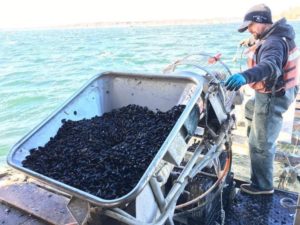Artificial Intelligence Could Help Scientists Predict Where And When Toxic Algae Will Bloom

In this 2018 file photo, a Bangs Island Mussels worker sets juvenile mussels onto a rope. (Fred Bever/Maine Public)
Climate-driven change in the Gulf of Maine is raising new threats that “red tides” will become more frequent and prolonged. But at the same time, powerful new data collection techniques and artificial intelligence are providing more precise ways to predict where and when toxic algae will bloom. One of those new machine learning prediction models has been developed by a former intern at Bigelow Labs in East Boothbay.
In a busy shed on a Portland wharf, workers for Bangs Island Mussels sort and clean shellfish hauled from Casco Bay that morning. Wholesaler George Parr has come to pay a visit.
“I wholesale to restaurants around town, and if there’s a lot of mackerel or scallops, I’ll ship into Massachusetts,” he says.
But business grinds to a halt, he says, when blooms of toxic algae suddenly emerge in the bay – causing the dreaded “red tide.”
Toxins can build in filter feeders to levels that would cause “Paralytic Shellfish Poisoning” in human consumers. State regulators shut down shellfish harvests long before danger grows acute. But when a red tide swept into Casco Bay last summer, Bangs Island’s harvest was shut down for a full 11 weeks.
“So when the restaurants can’t get Bangs Island they’re like ‘Why can’t we get Bangs Island?’ It was really bad this summer. And nobody was happy.”
As Parr notes, businesses of any kind hate unpredictability. And being able to forecast the onset or departure of a red tide has been a challenge — although that’s changing with the help of a type of artificial intelligence called machine learning.
“We’re coming up with forecasts on a weekly basis for each site. For me that’s really exciting. That’s what machine learning is bringing to the table,” says Izzi Grasso, a recent Southern Maine Community College student who is now seeking a mathematics degree at Clarkson University.
Read the rest of this story at Maine Public’s website.
